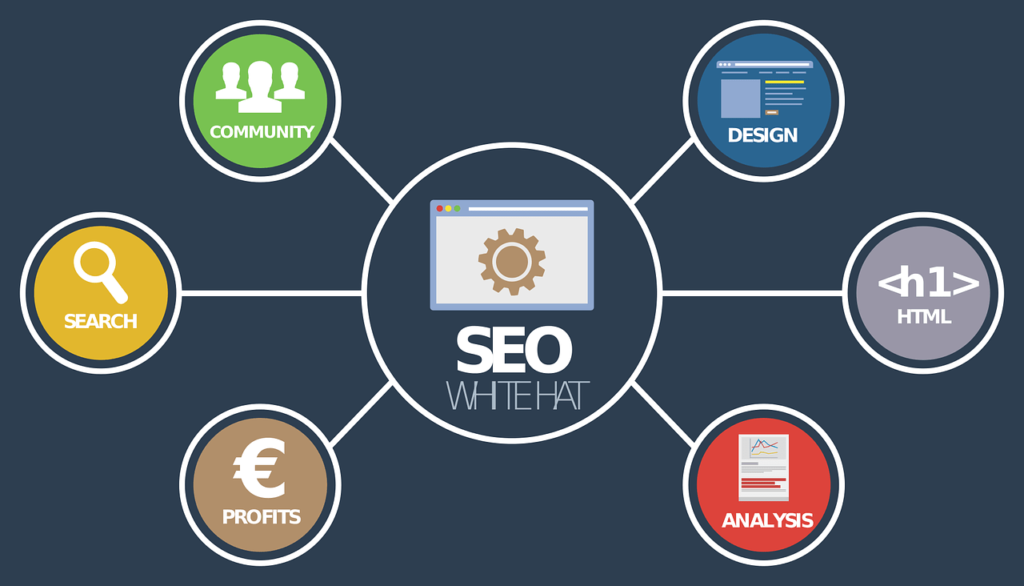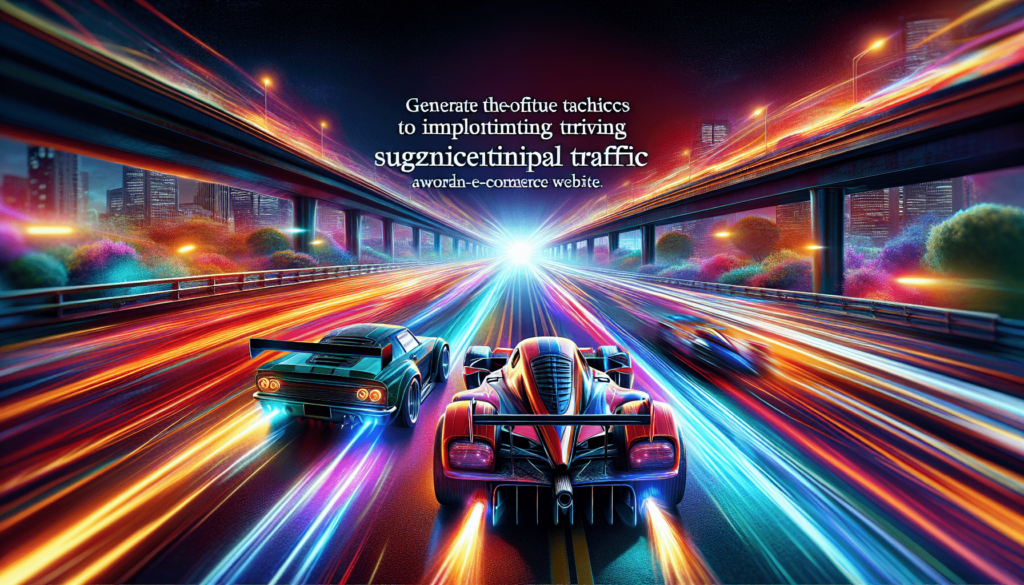Welcome to the ultimate guide on how to drive massive traffic to your e-commerce website using these 10 tactics! In today's digital age, standing out from the competition and attracting customers to your online store can be a challenging task. But fear not, as we are here to help you navigate through the vast world of online marketing strategies. From optimizing your website for search engines to utilizing social media platforms effectively, you'll learn all the tips and tricks to boost your website traffic and ultimately increase your sales. So buckle up and get ready to take your e-commerce business to new heights! Have you been struggling to drive traffic to your e-commerce website? Do you feel like you've tried everything, but still can't seem to attract visitors? Don't worry, you're not alone. Many online businesses face the same challenge. The good news is that there are proven tactics you can implement to increase your website traffic and ultimately boost your sales. In this article, we will discuss ten effective strategies that will help you drive massive traffic to your e-commerce website. Let's dive in!
Utilize Search Engine Optimization (SEO)
When it comes to increasing your website traffic, SEO is a crucial component. By optimizing your website for search engines, you can improve your ranking on search engine results pages (SERPs) and attract more organic traffic. Make sure to research relevant keywords for your products and services and incorporate them into your website content, meta tags, and image alt tags. Regularly update your site with fresh, high-quality content to enhance your SEO efforts.
How to Implement SEO on Your E-commerce Website
To optimize your e-commerce website for search engines:
- Conduct keyword research using tools like Google Keyword Planner or SEMrush.
- Include relevant keywords in your product descriptions, URLs, meta tags, and headings.
- Create a sitemap and submit it to search engines to improve crawlability.
- Optimize your website's loading speed and mobile-friendliness.
- Focus on creating valuable, user-friendly content that addresses your target audience's needs.
By paying attention to these SEO strategies, you can drive more organic traffic to your e-commerce website and increase your visibility in search engine results.
Leverage Social Media Marketing
Social media platforms are powerful tools for driving traffic to your e-commerce website. With billions of active users on platforms like Facebook, Instagram, Twitter, and LinkedIn, you have the opportunity to reach a vast audience and promote your products and services. Create engaging posts, run targeted ads, and interact with your followers to build a community around your brand. Make sure to include links to your website in your social media profiles and posts to drive traffic directly to your online store.
Tips for Effective Social Media Marketing
To make the most of social media marketing for your e-commerce website:
- Identify the platforms where your target audience is most active and focus your efforts there.
- Use high-quality images and videos to grab users' attention and showcase your products.
- Engage with your audience through comments, likes, shares, and direct messages.
- Run promotions, contests, and giveaways to incentivize users to visit your website.
- Analyze your social media metrics to understand what content resonates with your audience and adjust your strategy accordingly.
By harnessing the power of social media marketing, you can drive significant traffic to your e-commerce website and cultivate loyal customers who will keep coming back for more.

Invest in Paid Advertising
While organic traffic is valuable, paid advertising can provide a significant boost to your website traffic and sales. Platforms like Google Ads, Facebook Ads, and Instagram Ads allow you to target specific demographics, interests, and behaviors to reach potential customers who are likely to be interested in your products. Create compelling ad copy, eye-catching visuals, and clear calls-to-action to entice users to click on your ads and visit your website.
Types of Paid Advertising for E-commerce Websites
Some effective paid advertising options for e-commerce websites include:
- Search Engine Marketing (SEM): Pay-per-click (PPC) ads that appear at the top of search engine results pages.
- Display Advertising: Banner ads displayed on websites and platforms within Google's Display Network.
- Social Media Advertising: Promoted posts and sponsored ads on social media platforms like Facebook, Instagram, and Twitter.
- Retargeting Ads: Ads that target users who have previously visited your website but did not make a purchase.
- Influencer Marketing: Partnering with influencers to promote your products to their followers.
By investing in paid advertising, you can reach a larger audience, drive targeted traffic to your e-commerce website, and increase your conversion rates.
Create Compelling Content
Content is king when it comes to driving traffic to your e-commerce website. By creating valuable, engaging, and informative content, you can attract visitors to your site, establish your brand as an authority in your industry, and improve your search engine ranking. From blog posts and product descriptions to videos and infographics, there are numerous content formats you can leverage to connect with your audience and drive traffic to your website.
Types of Content to Drive Traffic to Your E-commerce Website
Some effective content types to consider for your e-commerce website include:
- Blog Posts: Share industry insights, product updates, and how-to guides to attract organic traffic.
- Product Descriptions: Write detailed and compelling descriptions that highlight the benefits of your products.
- Videos: Create product demos, tutorials, and behind-the-scenes videos to engage users.
- Infographics: Visualize data, statistics, and concepts in a visually appealing format to grab users' attention.
- User-Generated Content: Encourage customers to share reviews, testimonials, and photos of your products.
By consistently creating high-quality content that resonates with your target audience, you can drive more traffic to your e-commerce website and build brand loyalty among your customers.

Optimize Your Website for Conversions
Driving traffic to your e-commerce website is essential, but converting that traffic into sales is equally important. To maximize your conversion rates, optimize your website for user experience, performance, and functionality. Ensure that your website loads quickly, is easy to navigate, and has a seamless checkout process. Implement trust signals like customer reviews, security badges, and easy returns to build credibility and encourage users to make a purchase.
Conversion Rate Optimization (CRO) Strategies for E-commerce Websites
To improve your website's conversion rates:
- Simplify your website design and navigation to make it easy for users to find what they're looking for.
- Optimize your product pages with high-quality images, detailed descriptions, and customer reviews.
- A/B test your website elements, such as call-to-action buttons, colors, and messaging, to identify what converts best.
- Implement exit-intent pop-ups and cart abandonment emails to re-engage users who are about to leave.
- Offer special promotions, discounts, and incentives to encourage users to complete their purchase.
By focusing on conversion rate optimization, you can turn your website visitors into paying customers and maximize the ROI of your traffic-driving efforts.
Implement Email Marketing Campaigns
Email marketing is a powerful tool for driving traffic to your e-commerce website and nurturing customer relationships. By building an email list of subscribers who have opted in to receive updates and promotions from your brand, you can send targeted emails that drive traffic to specific product pages, promotions, and blog posts. Personalize your emails based on user behavior, preferences, and purchase history to enhance engagement and encourage repeat visits to your website.
Best Practices for E-commerce Email Marketing
To make the most of your email marketing campaigns:
- Segment your email list based on demographics, interests, and engagement levels to send relevant content.
- Use compelling subject lines and preview text to grab users' attention and increase open rates.
- Include clear calls-to-action and links to your website in every email to drive traffic.
- Test different email formats, timing, and messaging to optimize your campaigns for higher engagement.
- Monitor your email metrics, such as open rates, click-through rates, and conversions, to track your campaign performance.
By leveraging email marketing effectively, you can drive traffic to your e-commerce website, nurture leads, and increase customer retention and lifetime value.

Collaborate with Influencers and Partners
Influencer marketing and partnerships can be impactful strategies for driving traffic to your e-commerce website and expanding your reach. By collaborating with influencers in your industry or partnering with complementary brands, you can tap into their established audiences and leverage their credibility to promote your products. Whether through sponsored content, affiliate programs, or co-branded campaigns, influencers and partners can help you drive targeted traffic and boost your sales.
How to Partner with Influencers and Brands
To successfully collaborate with influencers and partners:
- Identify influencers and brands that align with your target audience, values, and brand voice.
- Reach out with a personalized pitch that highlights the benefits of working with your e-commerce website.
- Define clear objectives, expectations, and deliverables for the partnership to ensure mutual success.
- Monitor and measure the results of the collaboration to assess its impact on your website traffic and sales.
- Build long-term relationships with influencers and partners to continue driving traffic and conversions over time.
By partnering with influencers and brands, you can leverage their influence and audience to drive traffic to your e-commerce website and expand your customer base.
Optimize Your Website for Mobile Users
As more and more users access the internet on mobile devices, it's essential to optimize your e-commerce website for mobile users. A mobile-responsive design ensures that your website displays correctly on smartphones and tablets, providing a seamless browsing and shopping experience for mobile visitors. Make sure to prioritize mobile speed, usability, and navigation to cater to the growing segment of mobile shoppers and drive traffic from this valuable demographic.
Mobile Optimization Tips for E-commerce Websites
To make your website mobile-friendly:
- Use a responsive design that adapts to different screen sizes and resolutions.
- Optimize your images, videos, and content for quick loading and easy readability on mobile devices.
- Simplify your navigation and reduce unnecessary clicks to streamline the mobile user experience.
- Implement mobile-friendly checkout options, such as guest checkout and digital wallets, to increase conversions.
- Test your website on various mobile devices and browsers to ensure optimal performance for all users.
By prioritizing mobile optimization, you can cater to the growing number of mobile users and drive more traffic to your e-commerce website from this crucial source.

Analyze Your Website Analytics
To drive massive traffic to your e-commerce website, you need to understand where your traffic is coming from, how users are interacting with your site, and what actions they are taking. By regularly analyzing your website analytics, you can gain valuable insights into your traffic sources, user behavior, conversion rates, and ROI. Use tools like Google Analytics, Google Search Console, and heatmaps to track your website performance and make data-driven decisions to optimize your traffic-driving strategies.
Key Metrics to Monitor in Your Website Analytics
When analyzing your website analytics, pay attention to metrics like:
- Traffic Sources: Identify where your traffic is coming from (e.g., organic search, social media, paid advertising).
- User Behavior: Track user interactions, pages visited, time on site, bounce rates, and conversion funnels.
- Conversion Rates: Monitor your click-through rates, add-to-cart rates, checkout abandonment rates, and overall conversion rates.
- ROI: Measure the effectiveness of your traffic-driving strategies in terms of revenue, customer acquisition cost, and return on investment.
- Traffic Trends: Identify seasonality, trends, and patterns in your website traffic to optimize your marketing campaigns.
By analyzing your website analytics regularly, you can identify opportunities for improvement, capitalize on successful strategies, and drive more targeted traffic to your e-commerce website.
Engage with Your Audience
Building a strong connection with your audience is essential for driving traffic to your e-commerce website and fostering customer loyalty. Engage with your customers on social media, respond to their inquiries and feedback promptly, and provide personalized customer service to create a positive brand experience. Encourage user-generated content, reviews, and testimonials to showcase happy customers and build trust among potential buyers. By listening to your audience and delivering exceptional customer service, you can drive repeat traffic and referrals to your e-commerce website.
Ways to Engage with Your Audience
To build a loyal and engaged audience:
- Respond to comments, messages, and reviews on social media and review platforms to show that you value customer feedback.
- Personalize your communications and offers based on user preferences, behaviors, and interactions with your website.
- Encourage user-generated content, such as photos, videos, reviews, and testimonials, to showcase your products in action.
- Offer seamless customer service through live chat, email support, and social media to address customer inquiries and issues promptly.
- Run surveys, polls, and feedback forms to gather insights from your audience and tailor your marketing strategies accordingly.
By actively engaging with your audience and building authentic relationships, you can drive traffic to your e-commerce website, increase customer satisfaction, and foster brand advocacy among your loyal customers.
In conclusion, driving massive traffic to your e-commerce website requires a multifaceted approach that combines SEO, social media marketing, paid advertising, content creation, conversion rate optimization, email marketing, influencer partnerships, mobile optimization, website analytics, and audience engagement. By implementing these ten tactics strategically and consistently, you can attract more visitors to your online store, increase your conversion rates, and grow your e-commerce business successfully. Start implementing these strategies today and watch your website traffic and sales soar!

